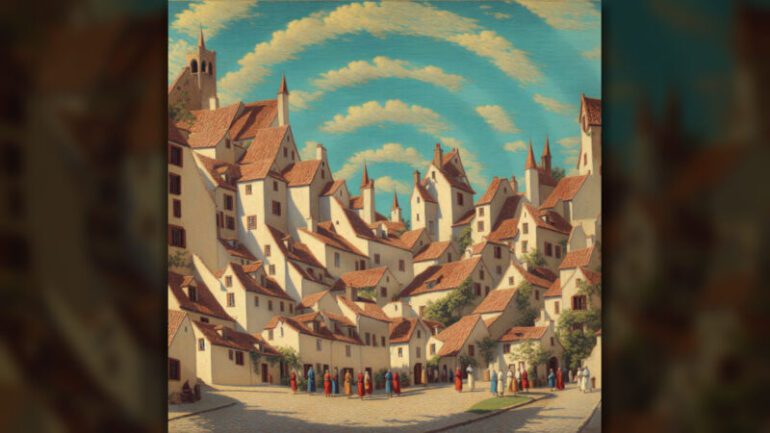TL;DR:
- An AI-generated spiral-shaped medieval village captivates social media, gaining popularity through a Reddit post by user “Ugleh.”
- Stable Diffusion and ControlNet, a novel guidance technique, were used to create these remarkable AI artworks.
- Reactions online vary from wonder and amazement to critical analysis of the AI-generated composition.
- Paul Graham, co-founder of Y-Combinator, lauds the artwork as a turning point in AI-generated art.
- ControlNet, introduced in a research paper in February 2023, empowers AI artists to replicate subjects’ shapes and postures more accurately.
- ControlNet has sparked a wave of creative experimentation, resulting in diverse and captivating AI-generated art.
- Despite offers to commercialize the art as NFTs, the creator, Ugleh, chooses to remain low-key.
- The legal status of AI-generated art remains uncertain under current US copyright policy.
Main AI News:
In a dazzling display of AI creativity, a spiraling medieval village has taken the social media landscape by storm. The image, generated by Reddit user “Ugleh,” has left netizens in awe of its intricate geometric design. The artwork, which was created using Stable Diffusion and the innovative ControlNet guidance technique, has garnered widespread acclaim, including a viral tweet boasting over 145,000 likes.
Reactions to this unique piece of generative AI art have ranged from wonder and astonishment to profound respect for the innovation it represents. One user exclaimed, “I’ve never seen anything quite like this—a true novelty in the world of art.” Meanwhile, seasoned AI artist Kali Yuga expressed, “Having witnessed countless AI art creations throughout my journey in this space, this piece stands out as one of the most exceptional. You’ve truly outdone yourself.”
Perhaps the most noteworthy endorsement came from Paul Graham, co-founder of Y-Combinator and a prominent commentator on social media tech trends. He declared, “This is the moment when AI-generated art transcends mere imitation. It’s as if the Turing Test has been redefined by this masterpiece.” While Graham’s reference to the Turing Test is metaphorical, his admiration for the work is undeniable.
However, not everyone was wholly convinced, as some users scrutinized the AI-generated spiral village’s compositional elements. Graphic designer Trent remarked, “It’s undeniably impressive, but there are numerous decisions here that a human artist wouldn’t make. The discrepancies in shadows and the placement of chimneys directly above windows defy conventional artistic logic. Upon closer inspection, the hallmark noise patterns of AI-generated art also become evident.”
Guided by the prompt for a “Medieval village scene with bustling streets and a distant castle (masterpiece:1.4), (best quality), (detailed),” ControlNet demonstrated its prowess by crafting scenes that harmonize with the perceptual patterns of spirals and checkerboards. In one image, the clouds gracefully curve overhead, and people naturally align in a spiral formation. In another, checkerboard-themed elements emerge from clouds, hedges, building facades, and a wagon cart.

A screenshot of Ugleh’s ControlNet process, used to create some of the images. Source: Condé Nast
Unlocking the Magic of ControlNet
The key to this creative breakthrough lies in ControlNet, a groundbreaking concept introduced in a research paper titled “Adding Conditional Control to Text-to-Image Diffusion Models.” Published by Lvmin Zhang, Anyi Rao, and Maneesh Agrawala in February 2023, ControlNet rapidly gained popularity within the Stable Diffusion community.
While Stable Diffusion relies on text or image prompts for AI image generation, ControlNet introduces an additional layer of guidance. This guidance can encompass information extracted from source images, such as pose detection, depth mapping, normal mapping, edge detection, and more. With ControlNet, AI artists can meticulously replicate the shape or posture of a subject depicted in an image, pushing the boundaries of creativity.
Incorporating ControlNet and similar prompts, enthusiasts have embarked on playful ventures, yielding captivating results. These include checkerboard-themed anime characters, animated renditions, a whimsical medieval village, and even a reimagining of “Girl with a Pearl Earring” set in a medieval village backdrop.
Despite the widespread attention and numerous offers to transform the artwork into NFTs (non-fungible tokens), Ugleh has chosen to maintain a low profile. On X, he humbly expressed, “I am grateful for the positive response to AI art, but I have no intentions of commercializing my recent creations. There won’t be any official interviews from my end. I’m just a regular tech-savvy AI enthusiast who dabbled with the innovative ControlNet technique.”
For those eager to explore the realm of ControlNet, a comprehensive tutorial is available on a dedicated website. Additionally, Ugleh has generously shared a step-by-step workflow, complete with spiral and checkerboard template files, on Imgur.
While these AI-generated artworks continue to astound, current US copyright policies suggest they may not meet the criteria for copyright protection, potentially placing them in the public domain. The ethical and legal implications of AI-generated art remain a contentious subject. However, creative enthusiasts persist in pushing the boundaries of what can be achieved by unskilled or untrained practitioners using these transformative tools. The ultimate question that looms is whether the law will ever acknowledge the essential spark of human inspiration that underlies these remarkable creations.




An AI-generated image of a medieval village in a checkerboard shape. Source: Condé Nast
Conclusion:
The emergence of AI-generated art, particularly through ControlNet-guided creations, is making significant waves in the digital art landscape. These innovative techniques enable a new level of precision and creativity, blurring the line between human and AI-generated artistry. As the market for digital art continues to evolve, it will be crucial to navigate the legal and ethical implications surrounding AI-generated works and their potential impact on the broader art market.

